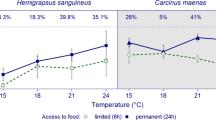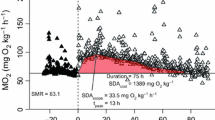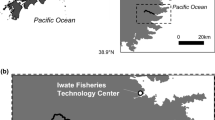Abstract
Juvenile sculpin (Cottus extensus) less than 30 mm long exhibit a diel vertical migration in the limnetic zone of Bear Lake (Utah-Idaho). Using mid-water and bottom trawls we found that these fish inhabit the bottom of the lake (5° C) during the day but migrate 30–40 m into the water column at night where they reside in the metalimnion or epilimnion at temperatures near 13–16°C. Larger fish do not migrate into the water column. Stomach analyses demonstrated that the young-of-the-year fish do not migrate into the water column to feed: from July to October their diet is 70–93% benthic ostracods and copepods, and pelagic prey are rarely consumed. Furthermore, gut fullness of the sculpin increases through the daylight period and decreases through the night, reaching minimum levels just before the dawn descent. Laboratory experiments demonstrated that the diel migration would increase digestion rate from 3%/h at profundal temperatures, to 22%/h in the warmer surface water, thus allowing the fish to empty their guts overnight and permit feeding the following day. Additionally, sculpin held in a temperature and feeding regime that mimicked that experienced by migrating fish grew 300% faster than those reared at 5° C. Given the overwhelming importance of fast growth for juvenile fishes, a post-feeding thermotaxs that increases digestion may be a common phenomenon increasing growth, and affecting the distribution and bioenergetic relationships of fish.
Similar content being viewed by others
References
Alexander RM (1973) The energetics of vertical migration by fishes. In: Sleigh MA, MacDonald AG (eds) The effects of pressure on organisms (Symp Soc exp Biol 26). Academic Press, New York, pp 273–294
Avery RA (1984) Physiological aspects of lizard growth: the role of thermoregulation. Symp Zool Soc London 52: 407–424
Bainbridge R (1961) Migrations. In: Waterman TH (ed) The physiology of crustacea VII. Academic Press, New York, pp 431–463
Begg GW (1976) The relationship between the diurnal movements of some of the zooplankton and the sardine Limnothrissa miodon in Lake Kariba, Rhodesia. Limnol Oceanogr 21:529–539
Biette RM, Geen GH (1980) Growth of underyearling salmon (Oncorhynchus nerka) under constant and cyclic temperatures in relation to live zooplankton ration size. Can J Fish Aquat Sci 37: 203–210
Blaxter JHS (1974) The role of light in the vertical migration of fish — a review. In: Evans GC, Bainbridge R, Rackham O (eds) Light as an ecological factor II. Blackwell, Oxford, pp 189–210
Brandt SB (1986) Ontogenetic shifts in habitat, diet, and diel-feeding periodicity of slimy sculpin in Lake Ontario. Trans Am Fish Soc 115: 711–715
Brett JR (1971) Energetic responses of salmon to temperature. A study of some thermal relations in the physiology and fresh-water ecology of sockeye salmon (Oncorhynchus nerka). Am Zool 11: 99–113
Brewer GD, Kleppel GS (1986) Diel vertical distribution of fish larvae and their prey in nearshore waters of southern California. Mar Ecol 27: 217–226
Carey FG, Kanwisher JW, Stevens ED (1984) Bluefin tuna warm their viscera during digestion. J Exp Biol 109: 1–20
Chapman DW (1978) Production. In: Bagenal TB (ed) Methods for assessment of fish production in fresh waters, 3rd edn. Blackwell, Oxford, pp 202–218
Christian KA (1986) Physiological consequences of nighttime temperature for a tropical herbivorous lizard (Cyclura nubila). Can J Zool 64: 836–840
Christian KA, Tracy CR (1984) Physiological and ecological consequences of sleeping-site selection by the Galapagos land iguana (Conolophus pallidus). Ecology 65: 752–758
Clark CW, Levy DA (1988) Diel vertical migrations by juvenile sockeye salmon and the antipredation window. Am Nat 131: 271–290
Coutant CC (1985) Striped bass, temperature, and dissolved oxygen: a speculative hypothesis for environmental risk. Trans Am Fish Soc 114: 31–61
Dalton RA, Lee TH, Hesse JL, Helm WT (1965) Distribution of sculpin, Cottus extensus, in Bear Lake, Utah-Idaho. Utah Acad Sci 42: 70–73
Dawadowitz P, Loose CJ (1992) Cost of swimming by Daphnia during diel vertical migration. Limnol Oceanogr 37: 665–669
Eggers DM (1978) Limnetic feeding behavior of juvenile sockeye samon in Lake Washington and predator avoidance. Limnol Oceanogr 23: 1114–1125
Enright JT, Honegger H-W (1977) Diurnal vertical migration: Adaptive significance and timing. Part 2. Test of the model: details of timing. Limnol Oceanogr 22: 873–886
Fortier L, Leggett WC (1983) Vertical migrations and transport of larval fish in a partially mixed estuary. Can J Fish Aquat Sci 40: 1543–1555
Enzenhofer HJ, Hume JMB (1989) Simple closing midwater trawl for small boats. N Am J Fish Manage 9: 372–377
Giguere LA, Dill LM (1980) Seasonal patterns of vertical migration: A model for Chaoborus trivittatus. In: Kerfoot WC (ed) Evolution and ecology of zooplankton communities. University Press of New England, Hanover, pp 122–1281
Green BF (1977) A practical interactive program for randomization tests. Am Statist 31: 37–39
Gliwicz MZ (1986) Predation and the evolution of vertical migration in zooplankton. Nature 320: 746–748
Gliwicz MZ, Pijanowska J (1988) Effect of predation and resource depth distribution on vertical migration of zooplankton. Bull Mar Sci 43: 695–709
Hamrin SF (1986) Vertical distribution and habitat partitioning between different size classes of vendace, Coregonus albula, in thermally stratified lakes. Can J Fish Aquat Sci 43: 1617–1625
Haney JF (1988) Diel patterns of zooplankton behavior. Bull Mar Sci 43: 583–603
Hassler TJ (1960) Relationship of certain environmental factors to the benthic fish densities in Bear Lake, Idaho-Utah. MS Thesis, Utah State University, Logan
He E, Wurtsbaugh WA (1993) An empirical model of gastric evacuation rates for fish and an analysis of digestion in piscivorous brown trout. Trans Am Fish Soc 122: 717–730
Hopkins TL, Baird RC, Milliken DM (1973) A messenger-operated closing trawl. Limnol Oceanogr 18: 488–490
Huey RB (1982) Temperature, physiology, and the ecology of reptiles. In: Gans C, Pough FH (eds) Biology of the Reptilia vol 12. Academic Press, New York, pp 25–91
Hurlbert SH (1984) Pseudoreplication and the design of ecological field studies. Ecol Monogr 54: 187–211
Hutchinson GE (1967) A treatise on limnology, vol. 2. Wiley, New York
Ikusemiju K (1967) The life history and ecology of Cottus sp. in Lake Washington. MS thesis, Unviersity of Washington, Seattle
Ikusemiju K (1975) Aspects of the ecology and life history of the sculpin Cottus aleuticus (Gilbert), in Lake Washington. J Fish Biol 7: 235–245
Janiczeek PMJ, Young AJ (1987) Computer programs for sun and moon illuminance with contingent table and diagram. Circ US Nav Obs 171: 1–132
Janssen J, Brandt SB (1979) Feeding ecology and vertical migration of adult alewives (Alosa pseudoharengus) in Lake Michigan. Can J Fish Aquat Sci 37: 177–184
Jude DJ, Madenjian CP, Schneeberger PJ, Tin HT, Mansfield PJ, Rutecki TL, Noguchi GE, Heufelder GR (1982) Adult, juvenile, and larval fish populations in the vicinity of the James H. Campbell Plant, 1981, with special reference to the effectiveness of wedge-wire intake screens in reducing entrainment and impingement of fish. (Special Report 96, Great Lakes Rescarch Division). University of Michigan, Ann Arbor
Kendall AW Jr, Naplin NA (1981) Diel depth distribution of summer ichthyoplankton in the middle Atlantic Bight. Fish Bull 79: 705–726
Kitchell JF (1969) The thermophilic and thermophobic responses of snakes in a thermal gradient. Copeia 1969: 189–191
Kraft CE, Kitchell JF (1986) Partitioning of food resources by sculpins in Lake Michigan. Environ Biol Fish 16: 309–316
Lamarra V, Liff C, carter J (1986) Hydrology of Bear Lake basin and its impact on the trophic state of Bear Lake, Utah-Idaho. Great Basin Nat 46: 690–705
Lampert W (1989) The adaptive significance of diel vertical migration of zooplankton. Funct Ecol 3: 21–27
Lentz D (1986) Aspects of the feeding ecology of the Bonneville cisco. MS thesis, Utah State University, Logan
Levy DA (1990a) Reciprocal diel vertical migration behavior in planktivores and zooplankton in British Columbia lakes. Can J Fish Aquat Sci 47: 1755–1764
Levy DA (1990b) Sensory mechanism and selective advantage for diel vertical migration in juvenile sockeye salmon, Oncorhynchus nerka. Can J Fish Aquat Sci 47: 1796–1802
Lock AR, McLaren IA (1970) The effect of varying and constant temperatures on the size of a marine copepod. Limnol Oceanogr 15: 638–640
Lillywhite HB, Licht P, Chelgren P (1973) The role of behavioral thermoregulation in the growth energetics of the toad, Bufo boreas. Ecology 54: 375–383
Marliave JB (1986) Lack of planktonic dispersal of rocky intertidal fish larvae. Trans Am Fish Soc 115: 149–154
Mac MJ (1985) Effects of ration size on preferred temperature of lake char Salvelinus namaycush. Environ Biol Fish 14: 227–231
Magnuson J, Crowder L, Medvick PA (1979) Temperature as an ecological resource. Am Zool 19: 331–343
McCauley RW, Huggins NW (1979) Ontogenetic and non-thermal seasonal effects on thermal preferenda of fish. Am Zool 19: 267–271
McDonald JG (1969) Distribution, growth, and survival of sockeye fry (Oncorhynchus nerka) produced in natural and artificial stream environments. Can J Fish Aquat Sci 26: 229–267
McLaren IA (1963) Effects of temperature on growth of zooplankton, and the adaptive value of vertical migration. J Fish Res Board Can 20: 685–727
Moreno EE (1989) Seasonal variation in the species composition, abundance, and size frequency distribution of zooplankton in Bear Lake, Utah-Idaho. MS thesis, Utah State University, Logan
Neill WE (1990) Induced vertical migration in copepods as defence against invertebrate predation. Nature 345: 524–526
Neverman D (1989) The diel vertical migration and feeding of underyearling Bear Lake sculpin Cottus extensus (Pisces, Cottidae). MS thesis, Utah State University, Logan
Neverman D, Wurtsbaugh WA (1992) Visual feeding by juvenile Bear Lake sculpin. Trans Am Fish Soc 121: 395–398
Nielson BR (1981) Bear Lake cutthroat trout enhancement program, 1981 Annual Report, Federal Aid in Fish Restoration, F-26-R-6. Utah Division of Wildlife Resources, Salt Lake City
Northcote TG (1967) The relation of movements and migration to production in freshwater fishes. In: Gerking SD (ed) The biological basis of freshwater fish production. Blackwell, London, pp 315–344
Ohman MD (1990) The demographic benefits of diel vertical migration by zooplankton. Ecol Monogr 60: 257–281
Orcutt JD, Porter KG (1983) Diel vertical migration by zooplankton: constant and fluctuating temperature effects on life history parameters of Daphnia. Limnol Oceanogr 28: 720–730
Pepin P (1991) Effect of temperature and size on development, mortality, and survival rates of the pelagic early life history stages of marine fish. Can J Fish Aquat Sci 48: 503–518
Persson L (1986) Patterns of food evacuation in fish: a critical review. Environ Biol Fish 16: 51–58
Peters RH (1984) Methods for the study of feeding, filtering and assimilation by zooplankton. In: Downing JA, Rigler FH (ed) A manual on methods for the assessment of secondary productivity in fresh waters, 2nd edn. Blackwell Scientific, Oxford, pp 336–412
Reynolds WW, Casterlin ME (1979) Behavioral thermoregulation and the “Final Preferendum” paradigm. Am Zool 19: 211–224
Seliverstov AS (1974) Vertical migration of larvae of the Atlanto-Scandian herring (Clupea harengus L.). In: Blaxter JHS (ed) The early life history of fish. Springer, Berlin, pp 253–262
Sinclair DC (1968) Diel limnetic occurrence of young Cottus asper in two British Columbia lakes. J Fish Res Board Can 25: 1997–2000
Smart EW (1958) An ecological study of the bottom fauna of Bear Lake Idaho and Utah. PhD thesis, Utah State University, Logan
Smith WG, Sibunka JD, Wells S (1977) Diel movements of larval yellowtail flounder, Limanda feruginea, determined from discrete depth sampling. Fish Bull 76: 167–178
Stevens ED, McLeese JM (1984) Am J Physiol 246 (Regulatory Integrative Comp Physiol 15): R487-R494
Stich H-B, Lampert W (1981) Predator evasion as an explanation of diurnal vertical migration of zooplankton. Nature 293: 396–398
Stich H-B, Lampert W (1984) Growth and reproduction of migrating and non-migrating Daphnia species under simulated food and temperature conditions of diurnal vertical migration. Oecologia 61: 192–196
Stuntz WE, Magnuson JJ (1976) Daily ration, temperature selection and activity of bluegill. In: Esch GW, McFarlane RW (eds) Thermal ecology II. National Technical Information Service, Springfield, Virginia, pp 180–184
Swift MC (1976) Energetics of vertical migration in Chaoborus trivittatus larvae. Ecology 57: 900–914
Vondracek B, Wurtsbaugh WA, Cech JJ Jr (1988) Growth and reproduction of the mosquitofish, Gambusia affinis, in relation to temperature and ration level: consequences for life history. Environ Biol Fish 21: 45–57
Warren CE (1971) Biology and water pollution control Saunders, Philadelphia
Werner EE, Gilliam JF (1984) The ontogenetic niche and species interactions in size-structured populations. Annu Rev Ecol Syst 15: 393–426
White JR, Li HW (1985) Determination of the energetic cost of swimming from the analysis of growth rate and body composition in juvenile chinook salmon, Oncorhynchus tshawytscha. Comp Biochem Physiol 81A:25–33
Williamson JH (1970) Stomach capacity, digestion rate, and 24-hour consumption rate for the Bear Lake sculpin (Cottus extensus). MS thesis, Utah State University, Logan
Workman GW, Sigler WF (1966) Distribution and abundance of small fishes in the littoral area of Bear Lake, Utah-Idaho. Utah Acad Sci Arts Letters 43: 29–42
Wright D, O'Brien WJ, Vinyard GL (1980) Adaptive value of vertical migration: A simulation model argument for the predation hypothesis. In: Kerfoot WC (ed) Evolution and ecology of zooplankton communities. University Press of New England, Hanover, pp 138–147
Wurtsbaugh WA, Hawkins C (1990) Trophic interactions between fish and invertebrates in Bear Lake, Utah-Idaho (Special Publication of the Ecology Center). Utah State University, Logan
Wurtsbaugh WA, Neverman D (1988) Post-feeding thermotaxis and daily vertical migration in a larval fish. Nature 333: 846–848
Zaret TM, Suffern JS (1976) Vertical migration in zooplankton as a predator avoidance mechanism. Limnol Oceanogr 21: 804–813
Author information
Authors and Affiliations
Rights and permissions
About this article
Cite this article
Neverman, D., Wurtsbaugh, W.A. The thermoregulatory function of diel vertical migration for a juvenile fish, Cottus extensus . Oecologia 98, 247–256 (1994). https://doi.org/10.1007/BF00324211
Received:
Accepted:
Issue Date:
DOI: https://doi.org/10.1007/BF00324211




